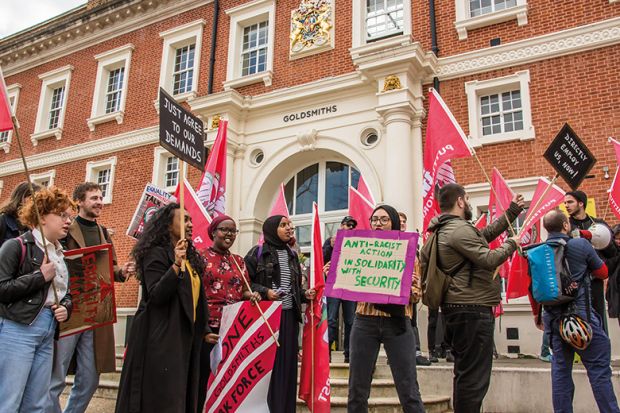With redundancies now being made at one in three UK campuses, relations between managers and staff appear to be at an all-time low – and nowhere has the dispute been more bitter than at Goldsmiths, University of London.
The institution is currently subject to a marking boycott and a global academic boycott by the University and College Union, and further strike action is already in the diary for the first week of the autumn term.
In part this recognises the scale of the cuts – 130 staff were originally set to be made redundant, including more than one in six academics, although this has since been reduced to 97 – and painful memories of the 10-month dispute over the last set of cuts in 2021-22.
But it also reflects the special place that Goldsmiths holds in the hearts of many students, graduates and researchers as a haven for creativity and radicalism, with film director Steve McQueen, writer Bernardine Evaristo and musician Damon Albarn among its alumni.
Many believe that this status is at risk in the latest round of bloodletting, not least as the layoffs are seen as targeting arts and humanities courses.
Unique courses such as the master’s in queer history and black British history are thought to be at risk after their convenors were handed redundancy letters. Goldsmiths’ sociology department has been particularly hard hit, with convenors of courses in race and social justice and gender studies selected for redundancy – even though these courses remain open for applications.
Justin Bengry, lecturer in queer history at Goldsmiths and the MA convenor now facing redundancy, said the institution was moving “further and further away from its commitment to marginalised people and their histories that was previously a cornerstone of the institution”. The course’s other staff member was let go in June.
“Goldsmiths’ reputation as a radical and creative university cannot be sustained without the people who bring that dynamism to the institution,” Dr Bengry said. “With neither staff nor the students invested in building upon Goldsmiths’ history as a radical and creative university, it will be utterly transformed, perhaps unrecognisably.”
Kesewa John, a lecturer in black British history who is at risk along with her master’s course, said Goldsmiths was “not as interested in social justice as we all thought”.
While she noted that responsibility to teach courses in marginalised areas should not fall on Goldsmiths alone, she warned that the lack of diversity within the higher education landscape means the closures of such programmes will leave students with “nowhere else to go”.
“You get rid of all those things and what you have left is bricks and mortar, and an institution that looks like all the other institutions across HE, but with less choice, because it’s much smaller,” Dr John said.
Goldsmiths’ latest financial statements, for 2022-23, show a mixed picture. The institution reported a net cash inflow from operating activities of £8.7 million, a turnaround from an £18.7 million shortfall the year before. But they flag declining income from domestic students at undergraduate and postgraduate levels, and say that savings made in previous years are “constantly being eroded” by inflation.
Goldsmiths’ transformation plan, published in April, warns of an expected £13.1 million shortfall against forecast tuition fee revenues this year – equivalent to 11 per cent of the institution’s entire budget. And it says that Goldsmiths is currently spending 62 per cent of its expenditure on staffing costs, an “unaffordable and unsustainable” level compared with the UK sector average of 43 per cent.
“These are difficult times for Goldsmiths and our students and staff and none of us wish to be in this position…However, not changing is sadly not an option and we must take these measures now to safeguard the institution’s future,” the transformation plan says.
“Following this period of transformation, we are confident we will be able to grow and enhance our position as a progressive and positive institution.”
But Catherine Rottenberg, professor of media, communications, and cultural studies at Goldsmiths and vice-president of the local UCU branch, said the fact that managers had identified law and computing as growth areas were signs that the university was moving away from its roots.
“We’ve had rumours that the senior management team really wants to rebrand Goldsmiths away from its traditional strength into more of a technical college, rather than the radical reputation it has,” she said.
And while much of the sector’s focus may be on Goldsmiths currently, its predicament is a sign of things to come for other UK higher education institutions, warned Les Back, who worked at the college for 28 years and is now head of sociology at the University of Glasgow.
Goldsmiths’ reputation as being a “profoundly open” institution and one of “different views of encounters” was “besieged”, he said. “If that’s not possible at Goldsmiths, then it means that the whole of the sector suffers. I think that’s the thing that is important to remember: this isn’t about one place,” he said.
“It’s about what the university can be in our time, and it feels to me like there is a kind of closing of the mind going on in the sector as a whole.”




